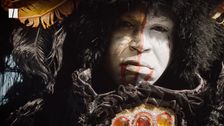[ad_1]

Mardi Gras Indians are an iconic part of New Orleans parade culture. Also known as Black Masking Indians, the group refers to Black men who dress up in colorful beaded suits influenced by Native American culture and who often have Native American ancestry.
They wear suits made of feathers, beads and other materials as a way of recognizing the history of oppression and racism that Indigenous and African people have experienced in the United States for centuries, as well as a way of celebrating New Orleans as a cultural melting pot dating back to its early days.
In the 1800s, mainstream Mardi Gras celebrations in New Orleans were held in predominantly white and affluent communities, excluding many of the poorer people living in the city.
“Mardi Gras is just the day that we use to rebel against what Mardi Gras has historically been: a day where Black people couldn’t enjoy Mardi Gras the same way other people enjoyed Mardi Gras,” Gizmo, a Mardi Gras Indian who requested to not use his last name for privacy reasons, told HuffPost.
Gizmo is a member of the Wild Tchoupitoulas, just one out of several “krewes” of Mardi Gras Indians who work and march together. Krewes are named after Native American tribes and have developed their own culture and traditions over time.
It’s hard to tell just by looking at a Mardi Gras Indian’s suit the sheer amount of work that goes into making one. Gizmo designs and sews all of his own suits, which he said requires significant amounts of time, money and energy. But he does it for the joy of dressing up on Mardi Gras morning and celebrating a culture that was traditionally denied to Black people.
“That’s what I’m going to use Mardi Gras for – it’s my day to do something woke and Black every single year,” Gizmo said.
Calling all HuffPost superfans!
Sign up for membership to become a founding member and help shape HuffPost’s next chapter
[ad_2]
Source link

